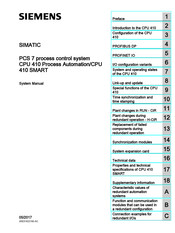Siemens SIMATIC 410 SMART Manuals
Manuals and User Guides for Siemens SIMATIC 410 SMART. We have 1 Siemens SIMATIC 410 SMART manual available for free PDF download: System Manual
Siemens SIMATIC 410 SMART System Manual (434 pages)
Process control system, Process Automation/CPU
Brand: Siemens
|
Category: Control Unit
|
Size: 20.08 MB
Table of Contents
-
1 Preface
17 -
-
-
-
-
RUN Mode101
-
STOP Mode102
-
STARTUP Mode103
-
HOLD Mode104
-
DEFECTIVE State106
-
Introduction107
-
Self-Test114
-
-
Security Levels134
-
-
Overview158
-
Overview172
-
Overview177
-
DP and PA Slaves190
-
Overview195
-
Error Displays196
-
-
The H-Cir Wizard197
-
Modify Hardware207
-
Modify Hardware215
-
-
-
-
The User Program306
-
PG Communication310
-
OP Communication310
-
S7 Communication310
-
Munication311
-
S7 Routing312
-
Data Set Routing316
-
Usable Networks325
-
Consistent Data340
-
Link-Up Sequence346
-
Update Sequence347
-
The User Program353
-
Cycle Time357
-
Response Time364
-
-
Index429
Advertisement
Advertisement
